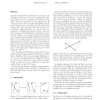Free Online Productivity Tools
i2Speak
i2Symbol
i2OCR
iTex2Img
iWeb2Print
iWeb2Shot
i2Type
iPdf2Split
iPdf2Merge
i2Bopomofo
i2Arabic
i2Style
i2Image
i2PDF
iLatex2Rtf
Sci2ools
CORR
2016
Springer
2016
Springer
Flip Distance to a Non-crossing Perfect Matching
A perfect straight-line matching M on a finite set P of points in the plane is a set of segments such that each point in P is an endpoint of exactly one segment. M is non-crossing if no two segments in M cross each other. Given a perfect straight-line matching M with at least one crossing, we can remove this crossing by a flip operation. The flip operation removes two crossing segments on a point set Q and adds two non-crossing segments to attain a new perfect matching M . It is well known that after a finite number of flips, a non-crossing matching is attained and no further flip is possible. However, prior to this work, no non-trivial upper bound on the number of flips was known. If g(n) (resp. k(n)) is the maximum length of the longest (resp. shortest) sequence of flips starting from any matching of size n, we show that g(n) = O(n3 ) and g(n) = Ω(n2 ) (resp. k(n) = O(n2 ) and k(n) = Ω(n)). Van Leeuwen and Schoone showed with the same argument and the same definition of...
| Added | 31 Mar 2016 |
| Updated | 31 Mar 2016 |
| Type | Journal |
| Year | 2016 |
| Where | CORR |
| Authors | Édouard Bonnet, Tillmann Miltzow |
Comments (0)

